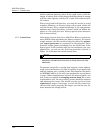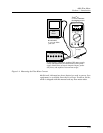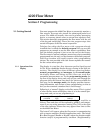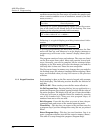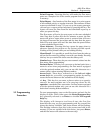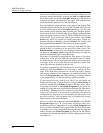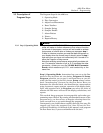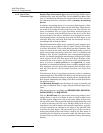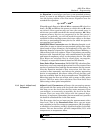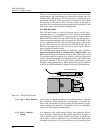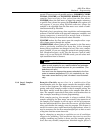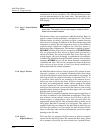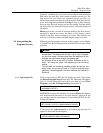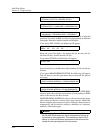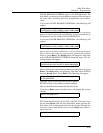
4220 Flow Meter
Section 2 Programming
2-6
2.3.2 Step 2, Flow
Conversion Type
Step 2, Flow Conversion Type, determines how the flow meter
calculates flow rate and total flow. For the 4220 Flow Meter, flow
rate is calculated by knowing the measured level and (usually)
the characteristics of a structure called a primary measuring
device.
A primary measuring device is a structure placed across a flow
stream through which the entire stream must flow. These devices
are made in a number of styles and sizes, but they all have one
thing in common: For any type of primary measuring device
there is a known relationship between the level in the flow
stream ahead of the device and flow rate through the device.
Consequently, after you measure level with the flow meter, it can
calculate flow rate and total flow from the measured level, by
consulting built-in look-up tables.
Detailed information about many commonly-used primary mea-
suring devices is provided in the Isco Open Channel Flow Mea-
surement Handbook. This useful book provides formulas, flow
rates at various levels, and values for maximum head, as well as
much interesting descriptive material, and is available from
Teledyne Isco. If your installation uses a nonstandard primary
device, you should consult the manufacturer of the device for flow
rates at given levels. The flow meter will then calculate a flow
conversion for such a device on the basis of the manufacturers'
data you enter as data points or an equation. In some
instances, a nonstandard primary device could be supplied with a
flow equation; you can enter that equation into the flow meter
and the flow meter will calculate the flow rate from that
equation.
Note however, that it is not always necessary to have a primary
measuring device. The 4220 Flow Meters can measure level and
calculate flow without having any primary device installed in the
flow stream. Sometimes the shape of the flow stream itself forms
the primary device.
The Manning formula uses the shape of a pipe or channel and
its slope to calculate flow in open (non-pressurized) pipe situa-
tions.
The conversion types available are WEIR/FLUME, MANNING,
DATA POINTS, and EQUATION.
You use Weir/Flume flow conversion when your primary mea-
suring device is a weir or a flume. A weir is a wall or dam across
the flow stream. Water must rise to the point where it flows over
the top of the wall. The measured level upstream behind the wall
is used to calculate the flow rate. Flumes differ from weirs in
that there is no wall or barrier, but instead a restriction, typically
a sharp narrowing or change in the slope of the channel that
restricts the flow. Again, the measured level of the stream at
some point ahead of the restriction is used by the flow meter to
calculate flow. In this flow conversion mode, the flow meter uses
internal look-up tables for many common primary measuring
devices.



